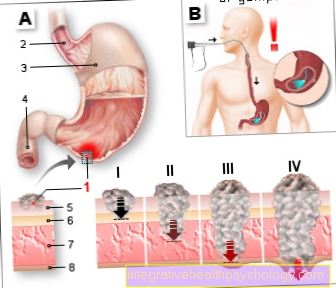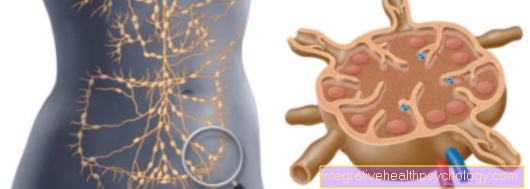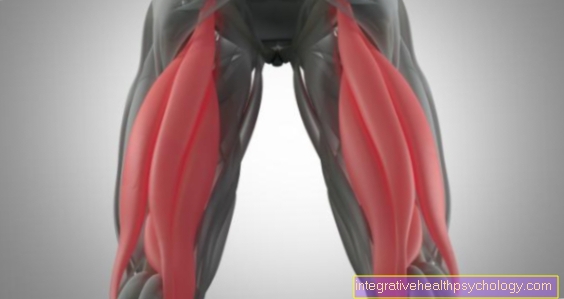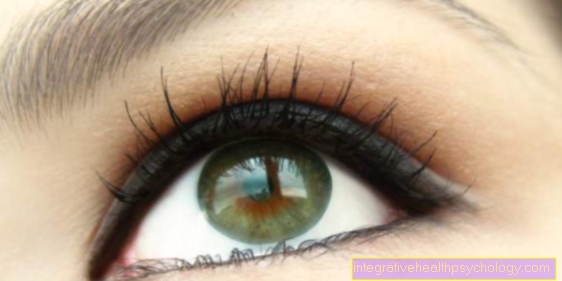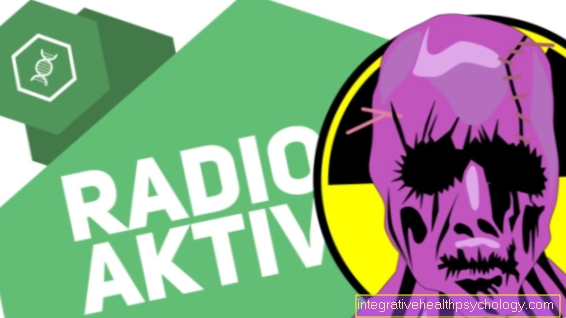Headache with nausea
introduction
It is not uncommon for people to experience headaches and nausea.
The possible causes are very diverse, but usually no more serious illness is hidden behind this combination of symptoms. Migraines are listed as the most common cause. Those affected often report that the headache usually starts slowly and only when it has reached a certain level does nausea begin. In addition to these symptoms, there is often a pronounced sensitivity to light, which is especially the case with migraines.
For headaches, most of those affected first resort to painkillers such as ibuprofen, aspirin or paracetamol. If these work sufficiently and the headache disappears, the nausea usually does too. From the described combination of symptoms of headache and nausea, a distinction must be made between the case that nausea only occurs after taking a painkiller. If taken regularly, these tablets can lead to over-acidification of the stomach, which then itself leads to a feeling of nausea and is therefore not part of the primary symptoms.

causes
There are many causes for the combination of headache and nausea. Depending on the severity and length of the symptoms, it is important to find out the cause and treat it.
The most common cause of the combination of headache and nausea is the classic migraine. It is often accompanied by sensitivity to light. In the case of a migraine, the headache is reported as throbbing, usually one-sided and strong to very strong. The accompanying nausea is excruciating and can often be so severe that it also leads to vomiting. In addition to migraines, serious neurological disorders can also result in a combination of headache and nausea. Cerebral haemorrhage should be mentioned here, which can occur either spontaneously or after an accident. Depending on which areas of the brain are affected, nausea can be more severe. But headaches are usually always present. Tension headaches can also lead to accompanying nausea.
The reason why headaches are often associated with nausea is because the regions in the head that control the nausea can also be irritated. Sometimes meningeal irritation also leads to such nausea. In rare cases, a so-called electrolyte shift, e.g. too little sodium in the blood can lead to a combination of headache, nausea and vomiting.
A deterioration in eyesight, which initially goes unnoticed, can also lead to headaches, which can also be accompanied by latent nausea. If the symptoms do not improve, an eye test should also be performed in any case. Blood pressure derailments can also result in a combination of headache and nausea, but can also cause dizziness. Especially with values above 170 mmHg, patients often complain about this triple combination of symptoms. Headache in combination with tiredness is usually an expression of a flu-like infection. Often other symptoms such as fever, cough or runny nose are missing.
Read more on the topic:
- Fever, dizziness and headache
- Causes of headache
Concomitant symptoms
In the case of headaches with nausea, the accompanying symptoms are usually indications of the cause of the symptoms. The main symptoms are presented below.
dizziness
The combination of headache and dizziness, which can then lead to severe nausea, is not uncommon in medicine.
In most cases, a so-called dizziness migraine, also called vestibular migraine, is the cause. This basically presents itself like a "classic" migraine (with headache, nausea and sensitivity to light), only that dizziness attacks are added here. These "attacks" are very variable in their duration and can last from a few minutes to several hours.
For the treatment of such dizziness, drugs against nausea (so-called antiemetics) and freely available painkillers such as aspirin or paracetamol are recommended.However, this recommendation only applies to those affected who do not regularly suffer from vertigo. If this is the case, alternative therapy options, such as taking beta-blockers, should be considered. It is also advisable to consult a doctor the first time a headache occurs with severe dizziness and nausea, so that he can rule out more serious causes.
In a small proportion of people who suffer from dizziness, it happens that they present themselves without a headache and therefore only focus on dizziness and the resulting nausea. This makes the diagnosis more difficult for the doctor, but indications such as any sensitivity to light and noise, which are also associated with a migraine, usually make them think of the correct diagnosis.
Also read the article on the topic: Dizziness, nausea and headache
fatigue
There are numerous causes that lead to headaches and fatigue. With this combination, the pain is usually more chronic than acute and can last for several days.
The most common cause of these symptoms is a common cold, which everyone has had to go through before. However, a viral flu (influenza) can also cause these symptoms. Usually these are then accompanied by fever, severe pain in the limbs and general fatigue. Chronic sinusitis, also known as sinusitis, if left untreated, can also lead to chronic fatigue and, due to the strong feeling of pressure, to chronic headaches. The latter are particularly intensified when the head is bent forward. In addition to these mostly viral causes, chronic high blood pressure can also lead to permanent fatigue and the development of headaches. After diagnosis, this should be treated with a healthy lifestyle and possible medication in order to reduce the long-term consequences of chronic high blood pressure.
Other possible causes that can cause this combination of symptoms are chronic liver disease, Pfeiffer's glandular fever, shingles of the face, cardiac arrhythmias, anemia or kidney disease.
Neck pain
Neck pain can be another symptom of another disease or a possible cause of headaches with nausea.
Most neck pain results from tension in the muscles in the area of the shoulders and neck, which can then lead to headaches. For some people, these are accompanied by pronounced nausea.
The best therapy consists primarily of loosening the neck muscles or eliminating another cause that is causing the tension. A normal cold or flu (influenza) can also lead to the symptoms described, which are then usually extended to include fever and general aches and pains.
Vomit
Almost all people have had severe headaches with nausea and vomiting at some point in their life.
The possible causes for this are very numerous. The most common, however, are sunstroke and migraines. In the former, the meninges are irritated by prolonged exposure to the sun, which leads directly to severe headaches without a clear focus and to nausea. However, the symptoms of sunstroke usually only last for a few hours.
Many migraine sufferers suffer from an acute attack in addition to severe headaches from nausea and vomiting. This is so often the case that specific migraine pain relievers have been designed that are already absorbed into the mucous membranes of the mouth and can thus take effect. The severe nausea often prevents the normal intake of tablets. However, nausea headaches can also be caused by more serious causes, such as a concussion or hemorrhage in the brain. For this reason, it is recommended that those affected who suffer from this combination of symptoms for the first time consult a doctor in order to rule out more serious causes.
diarrhea
If headaches occur together with nausea and diarrhea, this usually indicates an infection of the gastrointestinal tract.
The pathogens here are mostly bacteria such as Yersinia or Campylobacter, which are ingested through food and can then lead to food poisoning. This usually lasts only one to a few days and in most cases disappears on its own.
Another possible cause is that the headache is only caused by a lack of fluids, which can result from severe diarrhea. In such a case, it is important to drink as much as possible (at least 2 liters) and the headache will disappear after a few hours.
Another potential cause of these symptoms is the well-known flu, which, in addition to the typical cold symptoms and fever, can also be accompanied by severe headaches and diarrhea.
Hot flashes
Classically, headaches and hot flashes occur together primarily at the beginning of menopause, the so-called pre-menopause.
The development of the headache is attributed to the fluctuating hormone levels, especially the estrogen here. However, these fluctuations, and thus also the headache, usually decrease in the course of menopause.
The combination of hot flashes and headaches can also be signs of an autoimmune disease that affects the thyroid. In the so-called Graves disease, the body itself produces antibodies against certain parts of the thyroid gland, which then releases more hormones and can thus lead to the symptoms described. Other possible symptoms include excessive sweating, cardiac race, diarrhea, being underweight, and insomnia.
pressure on the ears
Headaches that go hand in hand with increased ear pressure can have various causes.
A cold, for example, which is accompanied by a build-up of mucus and swelling of the nasopharynx, in addition to causing headaches, can lead to the so-called Eustachian tube, also known as the ear trumpet, being blocked. This connects the middle ear and the throat with the function of adjusting the pressure of the ear to the external pressure. If the Eustachian tube is blocked, increased pressure can build up in the middle ear.
Another possible cause for the development of increased ear pressure with simultaneous headache is the grinding of teeth at night. This can be counteracted with a suitable dental splint.
Also read:
- Earache
- Otitis media
fever
The combination of headache, nausea and fever can be the first signs of the onset of meningitis, also known as meningitis.
This is usually caused by pathogens (viruses and bacteria) and, in addition to the signs described, is accompanied by severe neck stiffness, hypersensitivity to noise and light and sometimes a clouding of consciousness. Meningitis is a serious neurological disease that should be treated with therapy whenever possible.
A concussion can also be responsible for the described symptom combination. This is usually preceded by trauma or a strong shock, whereupon the symptoms set in within a few hours. However, a fever combined with a headache and nausea can also be a sign of a gastrointestinal tract infection, such as bacterial food poisoning.
stomach pain
Headaches that are accompanied by severe nausea and abdominal pain can be a sign of various causes.
The most common here is a gastrointestinal infection, which can be caused by various bacteria (campylobacter, Yersinia, etc.) and viruses (rotavirus, adenoviruses, noroviruses). Usually only symptomatic therapy is required here.
The mentioned combination of symptoms can, however, also be a sign of an excessively high stress level, which then presents itself, for example, in the form of an irritable bowel. Usually this is accompanied by a feeling of fullness, flatulence, diarrhea or constipation. Other possible causes are severe migraines or the beginning of pregnancy.
You may also be interested in this topic: Symptoms of pregnancy
Racing heart
The presence of a racing heart, along with a headache and occasionally nausea, may be a sign of an overactive thyroid. This is usually accompanied by increased sweating, insomnia and weight loss.
The cause for this can be an autonomous thyroid area, which eludes the regulatory function of the body and continuously produces thyroid hormones, or Graves' disease. The latter is an autoimmune disease that is associated with the production of antibodies against parts of the thyroid gland, which stimulates increased hormone production.
Also read: Therapy of an overactive thyroid
Eye pain
The most common diagnosis that ophthalmologists make when patients come to them with symptoms of headache, eye pain, and nausea is nearsightedness or farsightedness, which can be corrected by wearing glasses.
However, there are other, albeit rare, diseases that can cause these symptoms. One of these is what is known as acute glaucoma. In this disease, the intraocular pressure increases sharply in a very short time, which is reflected in the pressure on the optic nerves in eye pain and an increasing visual impairment.
Other possible rare causes are iritis, an inflammation of the iris, from the group of rheumatic diseases, and retrobulbar neuritis, inflammation of the optic nerve and the surrounding tissue.
Visual disturbances
If visual disturbances occur together with severe headaches and nausea, caution is advised at first, provided that no migraine is known in the medical history. In combination, these symptoms can be signs of increased intracranial pressure, which can be triggered, for example, by a cerebral haemorrhage. The first time these symptoms appear, it is clearly advisable to see your doctor in order to rule out worse causes. But even a severe migraine can be associated with the symptoms described. However, the visual impairment usually only lasts a few hours and can vary greatly in extent.
What are the symptoms of a migraine?
In addition to the severe headaches that are almost always associated with a migraine, there are a number of other symptoms that can occur.
The majority of those affected report an increased sensitivity to external stimuli, for example bright light or noise. These can then already be perceived to an otherwise normal extent, as very uncomfortable or even painful. In addition, different neurological disorders can occur depending on the type of migraine. These include eye flickering, sensory disturbances, loss of visual field or seeing flashes of light. However, these disorders never last longer than the actual headache.
The feeling of nausea or vomiting is also not uncommon for people who suffer from migraines. In most migraine headaches, the headache begins in the neck area and then moves towards the forehead, often dominating on one side. They are usually increased by physical exertion. Only in rare cases does a migraine attack occur without the typically strong throbbing headache.
Read more about this: Therapy for migraines
Can this be an indication of pregnancy?
During pregnancy, headaches combined with nausea can occur again and again.
As a rule, it is not a dangerous cause and only reflects the change in the body. However, a few dangerous causes must also be ruled out. Mention should be made of so-called preeclampsia, high blood pressure during pregnancy which, if left untreated, can lead to life-threatening seizures.
Some women report that they experienced increased headaches and nausea early in their pregnancy. While regular nausea, especially in the morning, can occasionally really be the first indication of a pregnancy, headaches are an extremely unspecific sign as there are innumerable causes for them.
Read more about this: Signs of pregnancy
therapy
Therapy is usually carried out symptomatically if no other causes that require treatment are found.
Painkillers are available for this, which can also be used during pregnancy (paracetamol). Iberogast or Vomex should make sure that the nausea goes away. It is very important to ensure that you drink enough water.
If ametropia is diagnosed, it can be corrected with glasses. In the case of electrolyte shifts (e.g. increased sodium), the cause of this should first be investigated and the sodium should then be balanced.
Even if high blood pressure is found, the cause should first be found out, especially in younger people. Sometimes kidney disease can cause high blood pressure to recur. If high blood pressure is already known or if it occurs again in older patients, an immediate reduction in blood pressure should be started (either by increasing the existing blood pressure medication or by adding a new medication).
In the case of headaches, nausea and diarrhea, care should be taken to ensure adequate fluid intake, but attempts can also be made to relieve the diarrhea symptomatically with perenterol.
All symptoms that include headache with nausea and that indicate a flu-like infection as the cause (joint and limb pain, fatigue) should rather be treated symptomatically, e.g. through appropriate pain treatment.
If there is no improvement in symptoms (nausea and vomiting), a neurological presentation should be considered. This usually takes place in a neurological clinic and, in addition to a detailed neurological examination, also includes imaging of the head. Either computed tomography (CT) or magnetic resonance imaging (MRI) can be used to find out whether the cause of the headache and nausea stem from a serious neurological disease. A brain tumor or cerebral haemorrhage would come into particular consideration here.
It is important to choose the right time for diagnostics. Too fast a diagnosis would exceed the financial framework and also expose the patient to unnecessary radiation (CT). It is also important not to treat the patient unnecessarily long with painkillers without knowing the exact cause. A serious neurological disease should always be considered, especially in young patients.
More information on this topic: Therapy for headaches
Home remedies for headaches with nausea
Since the headache symptom is probably as old as mankind, some home remedies have been found over time that are effective for headaches with nausea.
Above all, the peppermint oil should be mentioned here. This is available in various dilutions in drugstores and pharmacies. Very small amounts, approx. 1 drop, are rubbed onto the skin over the temples. After a few minutes, the rubbed in feels cool and the headache, including the nausea, usually subsides somewhat or completely.
In addition, if you have a headache, you should always make sure that you have drunk enough, as this is one of the most common causes of this. Other home remedies that many people swear by include drinking coffee with a dash of lemon or fresh ginger tea.
More on this: Home remedies for headaches
diagnosis
With the combination of headache and nausea, the first thing that should be done is a detailed medical survey (anamnesis), which includes how long the complaints have lasted and whether such complaints have ever occurred.
This is followed by a detailed physical examination of the patient. This includes measuring blood pressure, listening to the heart, lungs and abdomen, taking a temperature, measuring blood sugar and, if necessary, a blood test.
A neurological examination is also a decisive and important examination. What is important here is whether the head can be bent without discomfort and whether the pupils are on the same side or indifferent. A pupil of different sizes would indicate a serious neurological disease, such as a cerebral haemorrhage or a tumor.

